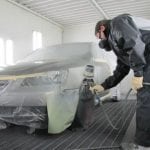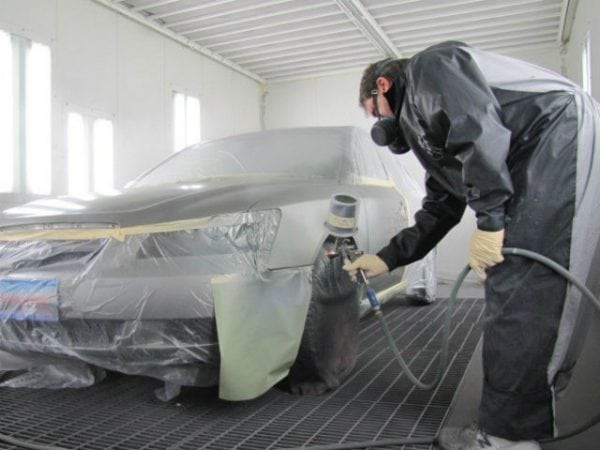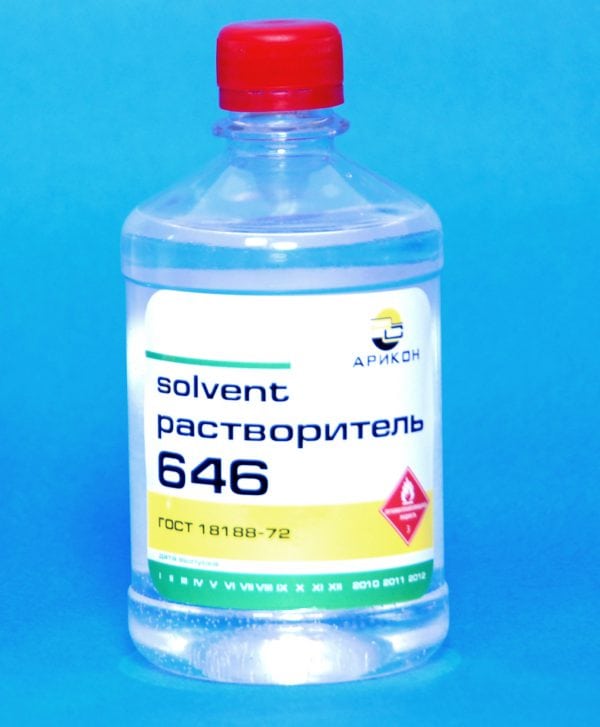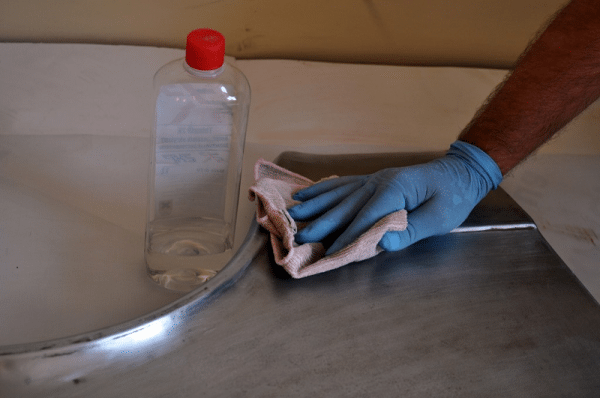Each master really wants that during the repair the paint on the products lay evenly, without stains and sagging, for a long time to maintain its freshness, original beauty. This can be achieved if an additional step is added to the standard scheme of work “surface cleaning - degreasing - priming - painting" and the primer itself is degreased before painting.
- Why do you need additional degreasing
- Better to use
- How to properly degrease
- Types of Degreasers
- Selection basics

To prepare large areas for finishing work, it is quite difficult to do this without special equipment. But for small items, the method is great. It is especially good to use it when painting metal products.
to contents ↑Why do you need additional degreasing
When this additional step is included in the preparation scheme before staining, it is possible to improve the performance of the finish coating:
- adhesion increases - enamel, varnish, paint lays more evenly, without streaks and stains.
- the product remains attractive for longer, the coating does not peel off.
- the protective properties of the paintwork last longer.
to contents ↑The degreasing of the primer layer consists in maximally cleaning the surface by removing oil and grease stains that have accidentally fallen from it, to ensure even application of the final layer.
Better to use
This process requires special attention, because the future appearance, quality characteristics and durability of the coating depend on the drug, which will be applied to the primer before applying the final layer.
- It is best to degrease with approximately what is supposed to be painted, and the product should be part of the paint. This will help to avoid a "chemical conflict", to ensure the most even coloring. For example, if it is supposed to use oil-based dyes, then turpentine is better to use: if it is not completely removed, then a small amount of it will not have any effect on the final result.
- This technique is applicable to all types of paints and varnishes. It is enough to read the composition of the solvent on the can and you can safely use it before painting. In this case, you can simply dip the brush in a solvent, walk it over the entire area of the product, let it dry - and you can paint it.
- Before applying varnish, paint, enamel, other final coatings, you can use the tool that is indicated on the can for dilution, or you can use such universal ones as gasoline, white spirit, acetone.
- For processing after priming wood and rubber coatings, gasoline is best suited.
- Prior to painting, it is better to treat priming mixtures for metal before painting with white spirit, kerosene, gasoline, solvent, freon (for stair railings, various fences).
- It is good to degrease stones with alcohol, technical or medical.
- Ammonia, white spirit are good for primed glass.
- Plastic is more delicate.Only mild neutral chemical compounds are suitable for it - ordinary solvents can damage not only the applied primer, but also the top layer of the product. It is better to use solutions like Antisilicon, PiTon.
Most amateur masters use gasoline, white spirit to degrease a primed surface, even table vinegar can be perfect for this purpose.
to contents ↑This is usually enough. The paint on the treated surface lays evenly, does not flake, lasts a long time.
How to properly degrease
To prepare the surface for painting, it is not enough just to wipe the grease stain with a cloth soaked in solvent, as is done when removing grease stains in the kitchen. Here is a slightly different technique: to soften the fat with a solvent and immediately wipe it off with a dry, clean, lint-free cloth, then re-walk through the solution for prevention.
Degreasing agents can be produced:
- special formulations in the form of aerosols;
- ordinary powders and liquids often used in everyday life.
For all of them, the technique for removing grease stains is the same.
Types of Degreasers
There are three types of chemical compositions that provide good degreasing of surfaces before painting:
- Organic carbon: solvent, xylene, kerosene, acetone, trichloromethane, methylene chloride. Very well remove grease stains from primed surfaces, prophylactically clean them before painting. Disadvantages: fire hazard, toxic.
- Emulsion: mixtures of organic solvents and aqueous-alkaline solutions with the addition of active substances. Non-combustible, have low toxicity, it is good to use for processing a large area.
- Based on synthetic detergents. Cheap, affordable, safe.
to contents ↑When using emulsion, synthetic products, surfaces must be thoroughly wiped with a cotton cloth and dried before painting.
Selection basics
Choosing the necessary tool, you should consider why it will be used:
- Preventive surface treatment, preparation for painting. In this case, for high-quality application of the finish coating, it is sufficient to use synthetic compounds.
- Removing grease stains that have occurred on the product after priming. Here, the tool is selected depending on the type, degree of contamination. The basis for choosing a degreaser will be its cleaning qualities.
When choosing a drug for work, you need to proceed from:
- effectiveness;
- safety at work, toxicity;
- cost;
- cost-effectiveness, consider consumption per 1 m²;
- ease of use.
When purchasing a degreasing agent in the store, you should choose a safe, non-toxic. The modern market can offer many highly effective solvents that do not adversely affect the human body.
When working with toxic compounds, care must be taken, use protective glasses, gloves, and a respirator.
Primed surfaces are best treated immediately before painting. If staining does not occur immediately, dust may settle on the product, which will significantly reduce the quality of subsequent work, disrupt the uniform distribution of the material, worsen adhesion, and may cause peeling.
The effectiveness of the treatment can be checked with a drop of water: if it spreads freely, then the process went right, all the fats are removed, and you can paint. If it hardens in place in the form of a ball, the cleaning procedure must be repeated.
Adding an additional stage of degreasing the primed surface before applying the finish coat significantly improves adhesion, improves the quality of work, the product retains a beautiful, fresh look for a long time.






